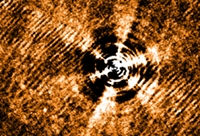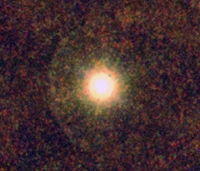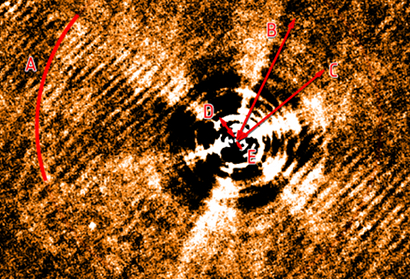Herschel probes the dusty history of a giant star
20 September 2011
About 5 thousand million years from now, our Sun will expand into a red giant, swelling to such a size that it may swallow the Earth. It will then begin to shed huge amounts of dust, surrounding itself with an expanding circumstellar envelope (CSE) that ultimately will become a planetary nebula. New insights into this process have been revealed by ESA's Herschel Space Observatory, which is providing unprecedented images of the complex, outer structure of a nearby CSE.
 |
|
A study of IRC+10216 has revealed a series of dust shells that have never been seen before. Credit: ESA/PACS/MESS Consortia |
Classified as an Asymptotic Giant Branch (AGB) star, IRC+10216 has evolved into a red giant, several thousand times bigger than the Sun, and is now nearing the final stages of its life.
Nuclear reactions in its core have transformed most of its hydrogen into helium, and the star is now characterised by an inert carbon-oxygen core, surrounded by two separate layers where nuclear fusion is taking place - an inner layer of helium and an outer layer of hydrogen. These layers are surrounded by a strongly convective outer envelope of hydrogen.
As the star evolves through the AGB phase, burning its nuclear fuel faster and faster, it is cooling and expanding, allowing dust to condense in its outer envelope. At the same time, IRC+10216 has begun to pulsate, causing a stellar wind of dust and gas to be expelled from its surface into the surrounding space. Measurements show that the dust is expanding outwards at a velocity of 14.5 km/s.
The presence of this dusty cocoon has been known for many years, but, until now, no instruments have been able to observe the structure of its cold outer regions, where the temperature plummets to –248 °C. Now, PACS infrared images taken at wavelengths of 70, 100 and 160 microns have revealed multiple dust shells in the circumstellar envelope of IRC+10216. The results are published this week in the journal Astronomy & Astrophysics.
The extremely sensitive PACS instrument has unveiled at least a dozen dust shells (or arcs) that have never been seen before. While arcs which had been ejected within the last 4000 years were previously observed up to 80 arc seconds from the star, the new images show material which was ejected some 16 000 years ago and is now visible at a distance of 320 arc seconds.
Arcs which were shed much earlier than this are no longer visible. Although the mass-loss process started some 220 000 years ago, the earliest arcs have been destroyed by the violent interaction of the stellar wind with the interstellar medium at the bow shock interface, about one light year (almost 9.5 million million kilometres) from IRC+10216.
Surprisingly, the almost spherical shells are non-concentric, of variable thickness, and unevenly spaced. The arcs contain some 50 per cent more dust mass than the smooth envelope and local density variations are also visible within one of the arcs.
The complex internal structure of the nebula is a record of how the star has been losing mass during the recent past. A number of possible explanations for the asymmetric structure of the dust shells have been examined by the authors of the new paper.
"The shell separation distances indicate that they were ejected some 500 to 1700 years apart," said Leen Decin from the Instituut voor Sterrenkunde, Katholieke Universiteit Leuven, Belgium, lead author of the paper.
"The irregular spacing between the arcs suggests that the structure is not caused by the regular gravitational perturbations associated with an unseen binary companion in orbit around the star.
"A second hypothesis favours enhanced dust formation from magnetic cool spots on the star, rather like the coronal mass ejections which are associated with sunspots. However, the large size of the arcs suggests that there would have to be several sizeable starspots existing in close proximity at the same time. Furthermore, the spacing of the shells shows no evidence of the periodicity that would be expected if the star was experiencing a cycle of rising and falling magnetic activity, like our Sun.
"It seems more likely that the arcs are caused by slight variations in ejection velocity or in the time the ejection took place as the star pulsates and loses mass. Variations in the clumpiness of the dust, associated with temperature variations in the nebula, may also play a part."
Located some 500 light years from Earth, IRC+10216 is one of the best-known examples of the 150 or so evolved stars which are being studied in the MESS survey, one of the guaranteed time, key observational programmes being undertaken with the PACS and SPIRE instruments on board Herschel.
"The angular resolution of these instruments provides accurate maps of the far infrared emission of different types of evolved stars," said Groenewegen from the Observatory of Belgium in Brussels, Investigator of the MESS programme. "This helps us to infer detailed information on the mass, size and structure of the dust shells, and possible grain size/temperature gradients, significantly improving our knowledge of the mass-loss history of these giant stars."
 |
|
Herschel image of IRC+10216 (CW Leonis). The bow shock is clearly visible to the left of the star. Credit: ESA/PACS/SPIRE/MESS Consortia |
The new PACS detection of arcs in the outer envelope confirms that the nebula surrounding IRC+10216 is variable in structure, and that photochemistry is an important process in creating warm water vapour.
"By virtue of its large telescope enabling us to see these structures in such fine detail, Herschel is adding to our understanding of this iconic star," commented Göran Pilbratt, ESA's Herschel Project Scientist.
Reference publicationL. Decin, et al., "Discovery of multiple dust shells beyond 1 arcmin in the circumstellar envelope of IRC+10216 using Herschel/PACS". Published online in Astronomy & Astrophysics on 20 September 2011.
Contacts
Leen Decin
Katholieke Universiteit Leuven
Department Natuurkunde en Sterrenkunde
Belgium
Email: Leen.Decin ster.kuleuven.be
ster.kuleuven.be
Phone: +32 16 327041
Martin Groenewegen
Royal Observatory of Belgium
Ringlaan 3
B-1180 Brussels
Belgium
Email: marting oma.be
oma.be
Phone: +32 2 3730203
Göran Pilbratt
Herschel Project Scientist
Research and Scientific Support Department
Science and Robotic Exploration Directorate
ESA, The Netherlands
Email: gpilbratt rssd.esa.int
rssd.esa.int
Phone: +31 71 565 3621


